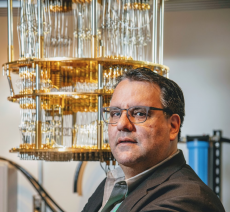New CRD Group Enhances Berkeley Lab QIS Research
Focus is on developing, fabricating, testing, and operating world-class quantum processors
January 21, 2021
By Kathy Kincade
Contact: cscomms@lbl.gov
Quantum information science (QIS) is, by nature, a highly collaborative and interdisciplinary endeavor. Multiple components must come together to seamlessly enable a common goal: a new paradigm in computation with novel capabilities stemming from quantum mechanics. And it takes time – sometimes years – to design, build, and figure out how to integrate the diverse pieces of this next-generation computing infrastructure for practical applications.
Consider the Advanced Quantum Testbed (AQT) at Lawrence Berkeley National Laboratory. Established in 2018 through funding from the U.S. Department of Energy, the testbed is helping researchers from around the world evaluate and develop a variety of superconducting quantum processor technologies. The processors are used to demonstrate novel quantum algorithms and simulations that push the boundaries of the physics of controllable quantum entanglement on demand.
But the AQT is just one component of Berkeley Lab’s growing quantum ecosystem. For more than a decade, physicists, engineers, materials scientists, and computer scientists at the Lab have been at the forefront of QIS research. These efforts recently took another step forward with the establishment of the Quantum Information Science and Technology (QuIST) group. As part of the Computing Sciences Area’s Computational Research Division (CRD), QuIST consolidates multiple quantum hardware development efforts - and quantum algorithm demonstrations on that hardware - currently encompassed by the AQT and the Quantum Systems Accelerator (QSA), another multidisciplinary project led by Berkeley Lab.
“QuIST is a team that designs, fabricates, deploys, and operates quantum processors based on superconducting electronics. It is kind of unique in CRD because the focal point is quantum hardware,” said David Santiago, acting group lead for QuIST and science and technology lead for the AQT. “That is why we are establishing a standalone group at Berkeley Lab that can execute the developments in QIS theory and algorithms. Our focus is on the experimental design of the hardware and operating the processors for algorithms and simulations.”
The QuIST team is working to make the best quantum chips in the world to help the scientific community advance science and accelerate discoveries, Santiago added. “There are not that many people at the Lab or around the world who can build quantum processors,” he said.
“The Lab’s rapid development of a world-recognized, impactful QIS program has been very impressive,” said David Brown, CRD Division Director. “The QuIST group’s emphasis on novel quantum hardware research associated with AQT and QSA adds an important element to CRD’s ongoing QIS research activities in quantum algorithms, software, and hardware.”
About Berkeley Lab
Founded in 1931 on the belief that the biggest scientific challenges are best addressed by teams, Lawrence Berkeley National Laboratory and its scientists have been recognized with 16 Nobel Prizes. Today, Berkeley Lab researchers develop sustainable energy and environmental solutions, create useful new materials, advance the frontiers of computing, and probe the mysteries of life, matter, and the universe. Scientists from around the world rely on the Lab’s facilities for their own discovery science. Berkeley Lab is a multiprogram national laboratory, managed by the University of California for the U.S. Department of Energy’s Office of Science.
DOE’s Office of Science is the single largest supporter of basic research in the physical sciences in the United States, and is working to address some of the most pressing challenges of our time. For more information, please visit energy.gov/science.










